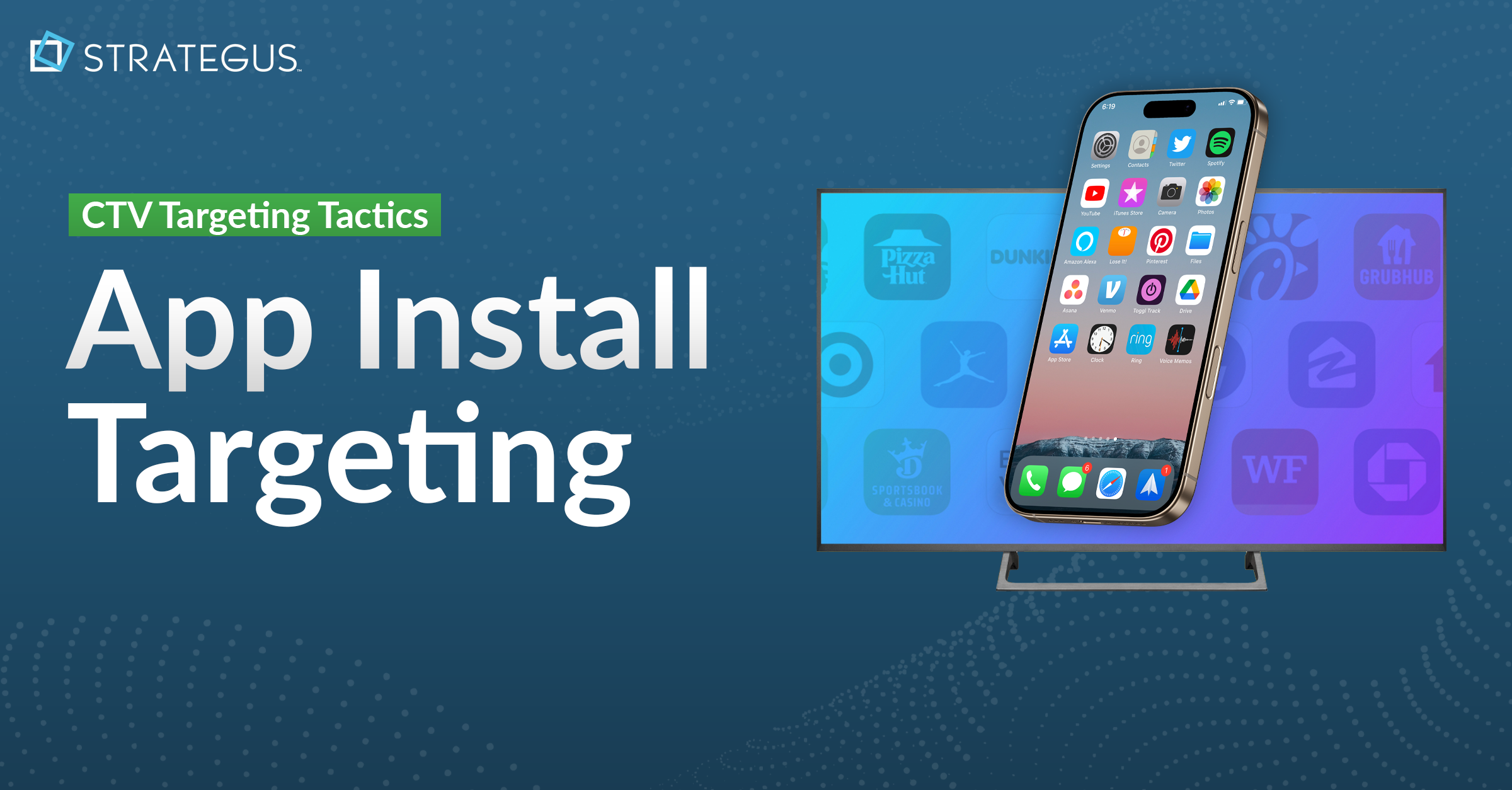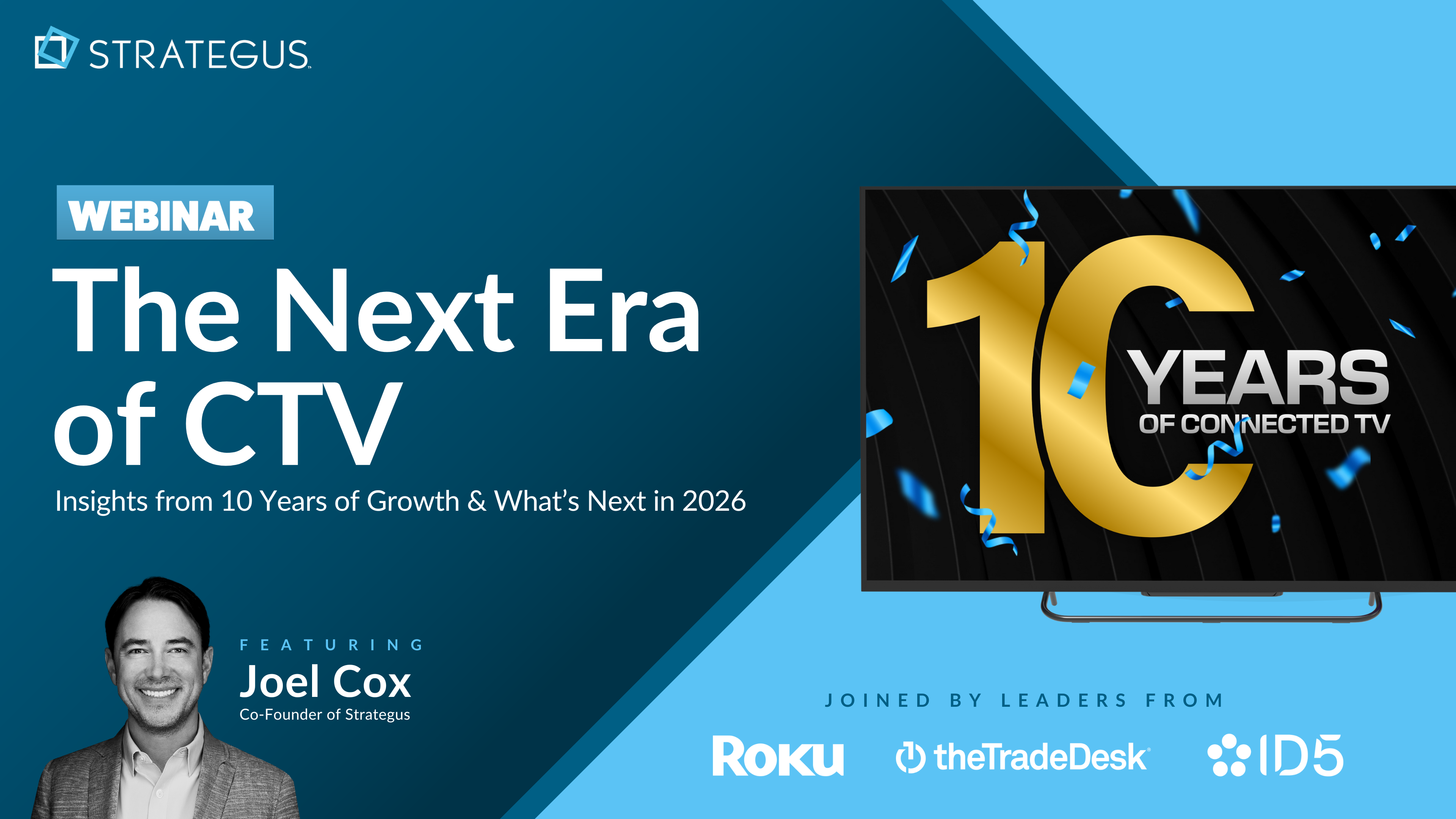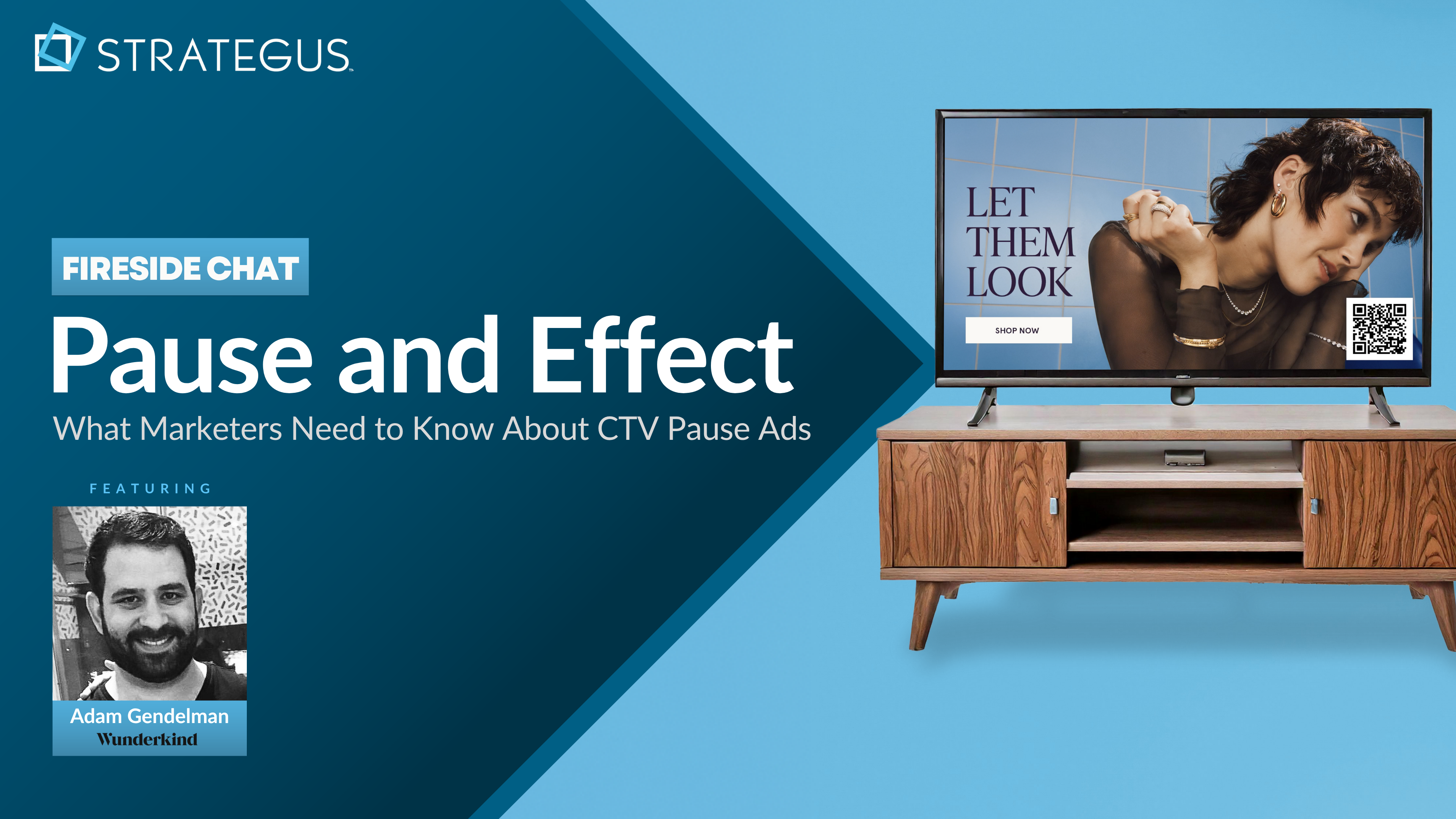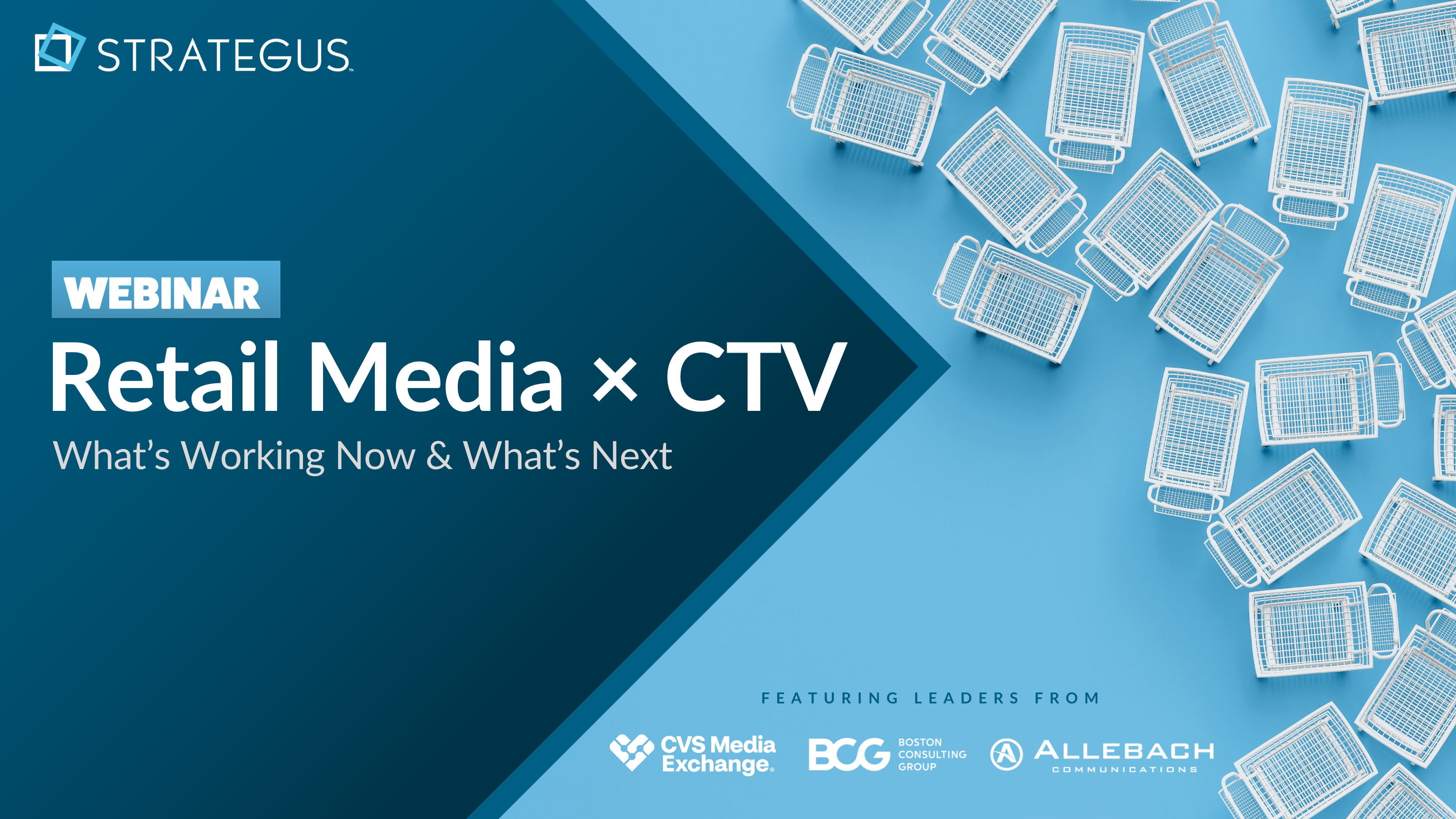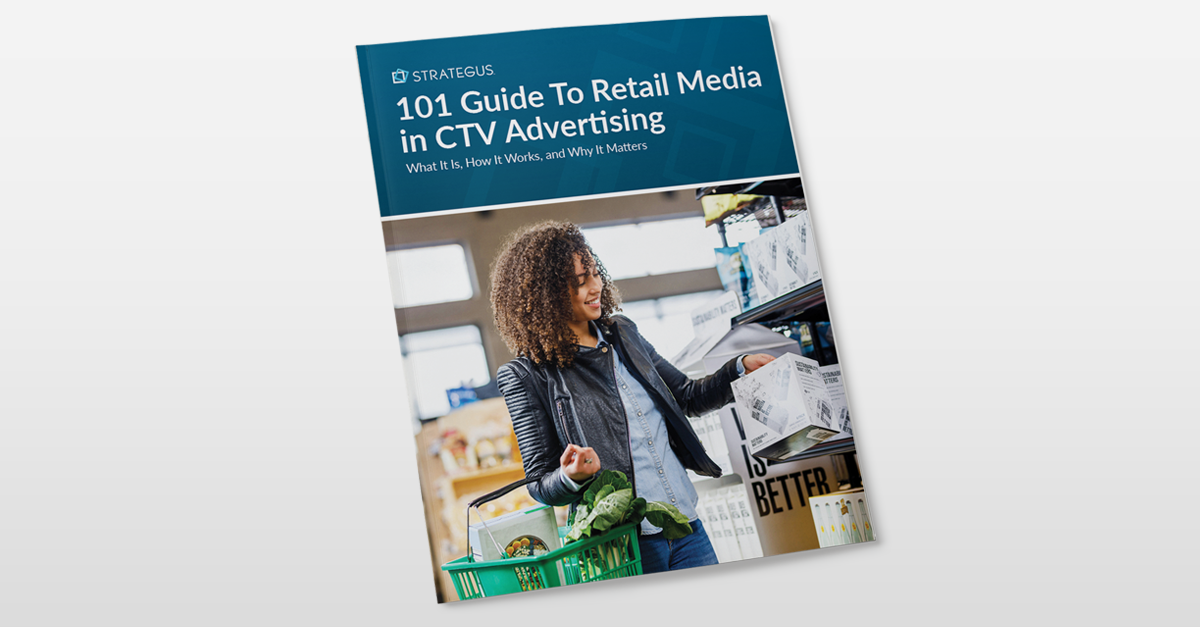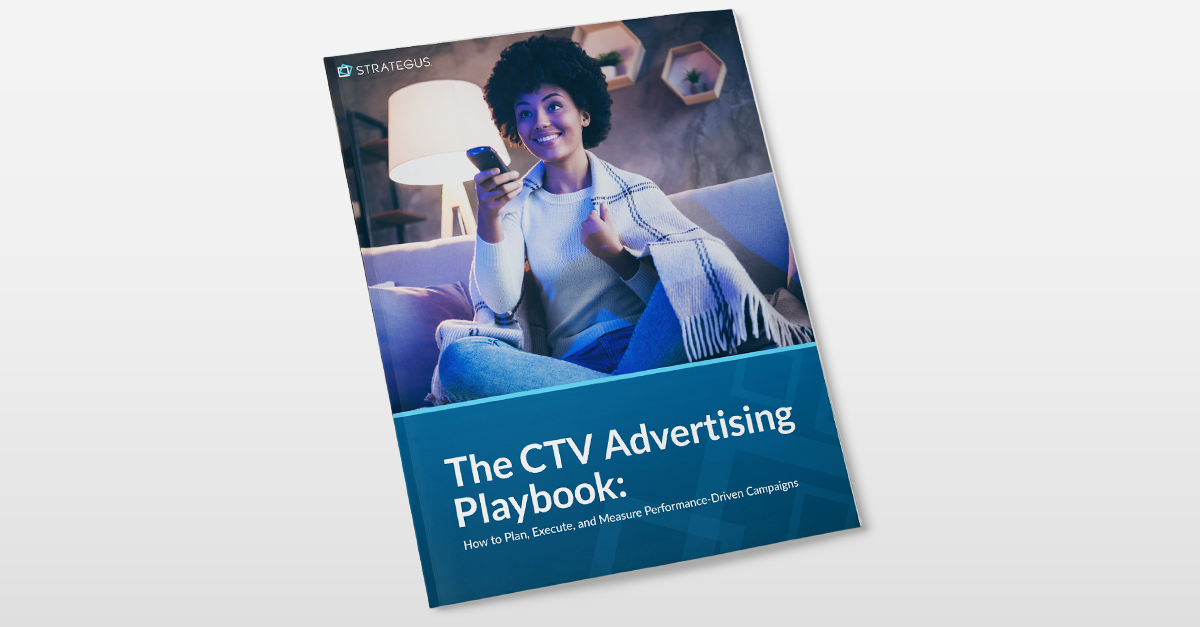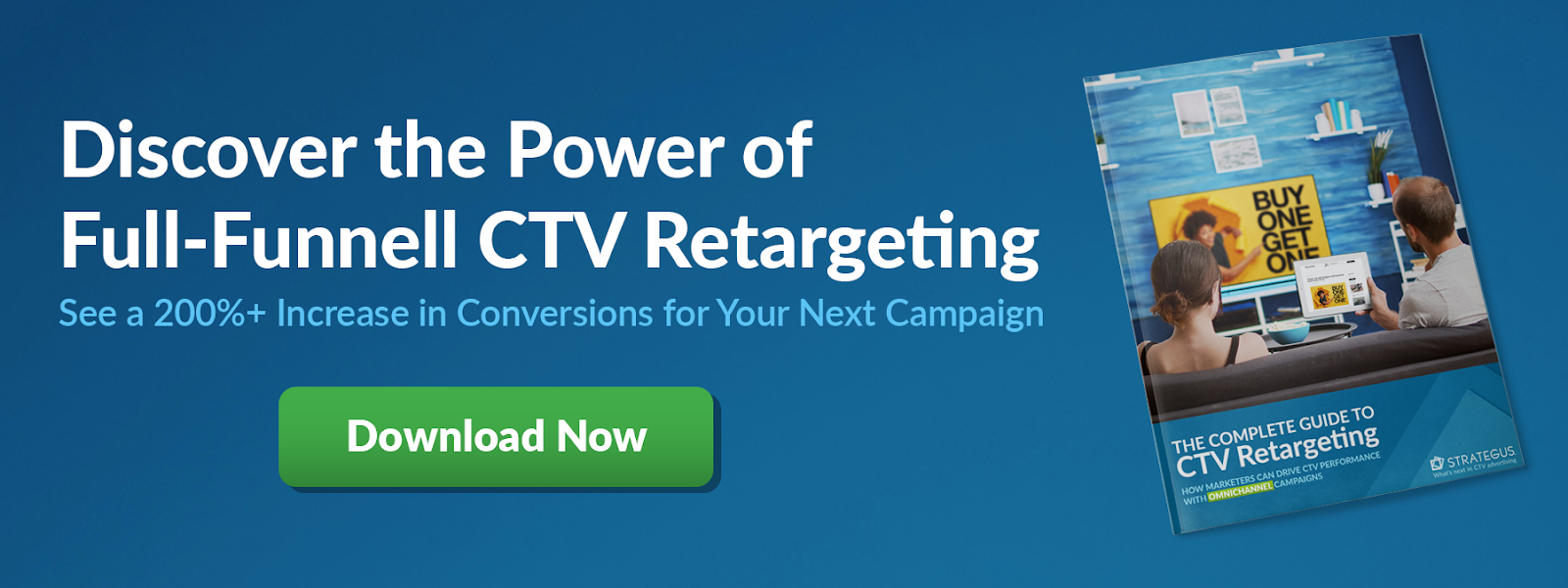- Home
- Strategus Blog
- What is Third-Party Data Targeting for CTV: Benefits & Tactics
What is Third-Party Data Targeting for CTV: Benefits & Tactics
 Traci Ruether
Traci Ruether
11 minutes read
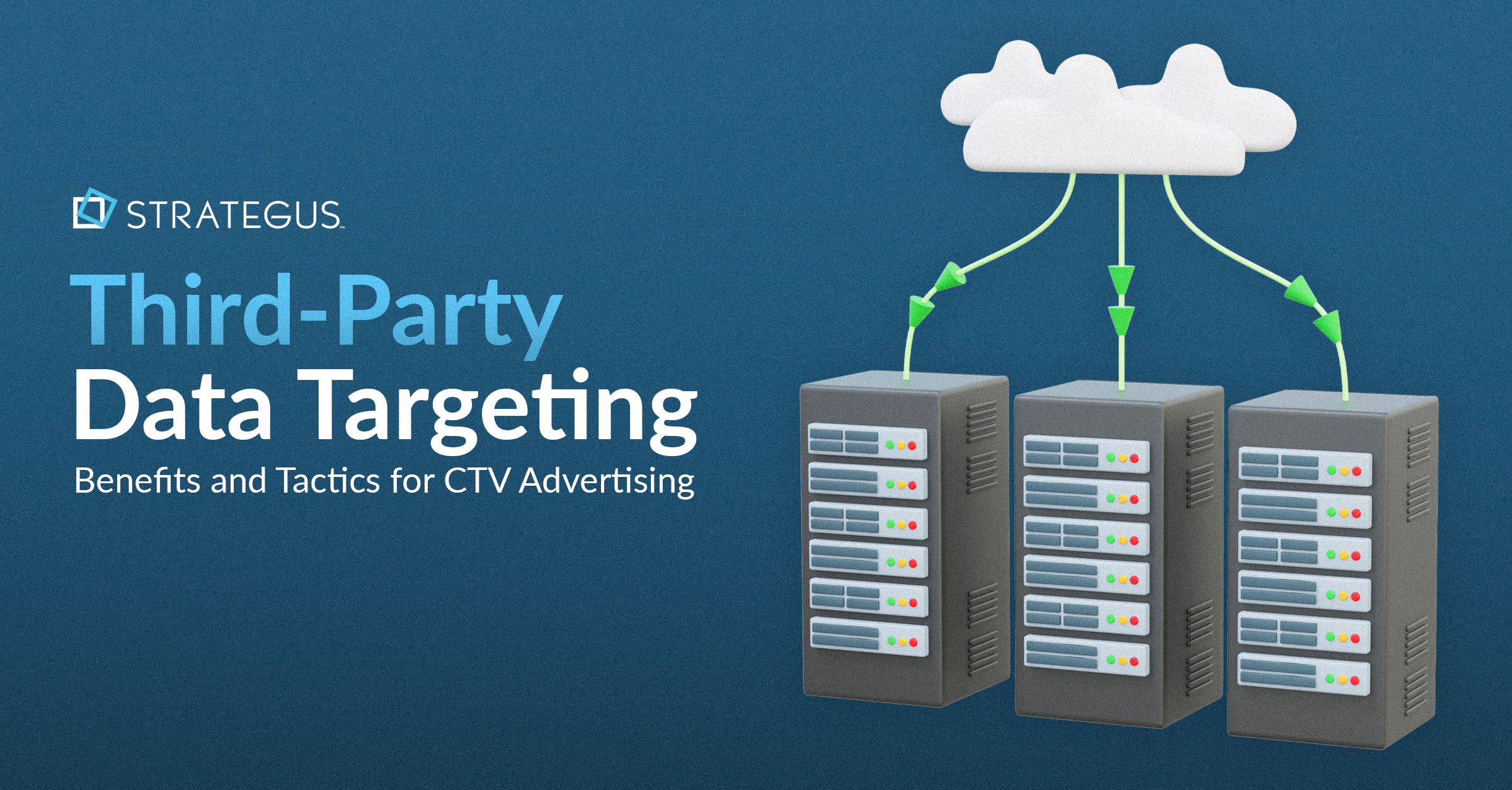
Every ad you see online is powered by data. While first-party data comes from your own customers, third-party data helps you find new audiences and understand bigger market trends.
In connected TV (CTV) campaigns, it shows who is watching, what they like, and where to reach them.
But, knowing how to make the most of this data is the decision-maker that leads you to good or bad results. Here’s everything you need to know about how to use third-party data to make your CTV ads smarter and more effective.
Key Takeaways
- Third-party data comes from external sources that track demographics, interests, behaviors, and purchase intent, helping advertisers find new audiences beyond their existing customers.
- In connected TV (CTV), this data powers precise targeting by showing who viewers are, what they watch, and when they’re most likely to engage with ads.
- Key targeting methods include demographic, behavioral, geographic, contextual, and intent-based strategies that align ads with real viewer interests and actions.
- Combining first-party and third-party data allows advertisers to scale reach, refine accuracy, and maintain privacy compliance through cookie-free identity matching.
- Despite stricter privacy rules, third-party data remains essential for expanding audience reach, tracking market trends, and improving campaign performance.
- Strategus combines powerful data insights with privacy-safe CTV strategies that reach the right viewers on every screen. Speak to a Strategus expert today.
What is Third-Party Data?
Third-party data is information collected by outside companies that don’t have a direct link to your business. These CTV data sources gather details like interests, shopping habits, and online behavior from many places, then sell that data to advertisers.
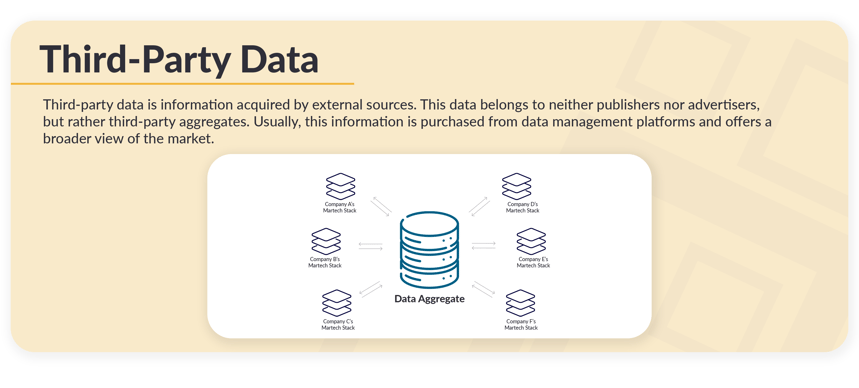
Think of it as asking the person sitting next to you at the bar for advice instead of your closest friend. It may not be as personal as your own first-party data, but third-party audience data can still have valuable data you can use to improve your targeting. With third-party data, what people are watching, buying, or searching for across the web.
Types of Third-Party Data
Third-party data comes in many forms, and each type helps you understand your audience in a different way.
- Demographic Data: This includes details like age, gender, income, education, and location. It helps you group people by who they are and reach broad audiences at the start of a campaign.
- Behavioral Data: This tracks how people browse, shop, and use apps. It helps you find users based on their habits and understand what they like to buy.
- Contextual Data: This connects your ads to the content people watch, read, or listen to. It makes sure your message appears in the right place at the right time.
- Interest-Based Data: This focuses on people’s hobbies, passions, and lifestyle choices. It helps you reach audiences who share similar interests or tastes.
- Intent Data: This shows when someone is close to buying. It helps you target users who are actively looking for products or services like yours.
How to Use Third-Party Data for CTV Targeting
Advertisers use different tactics to turn third-party audience data into real CTV results. Each approach focuses on reaching viewers more precisely and improving CTV ad optimization.
Here’s how you can use third-party data for better CTV targeting:
Demographic Targeting
Demographic targeting segments audiences based on fundamental characteristics like age, gender, household income, education level, and geographic location. This targeting method transforms broad viewer pools into manageable segments, allowing advertisers to craft messages that work well with specific life stages and socioeconomic profiles.
While demographic targeting is basic compared to newer targeting methods, this data remains the backbone of advertising as a whole.
Why Demographic Targeting Matters
Demographic targeting ensures your ad dollars reach the right households without waste. It's particularly powerful for brands with clearly defined customer profiles. For example, luxury goods targeting high-income households or educational apps reaching parents with school-age children.
This targeting method helps brands maintain consistent messaging across platforms while adapting creative elements to match viewer demographics. A financial services company might target young professionals with student loan refinancing ads while reaching older demographics with retirement planning messages.
Geotargeting
Geotargeting uses location data to deliver CTV ads based on viewers' physical locations, from broad DMA regions down to specific ZIP codes or radius targeting around store locations. This precision allows brands to customize messaging for regional preferences, local events, and weather conditions.
Modern geotargeting factors in commute patterns, frequent locations, and even differentiates between residential and commercial viewing environments, making every impression count.
Why Geotargeting Matters
Location-based targeting transforms CTV from a mass-reach channel into a precision tool for driving local action. Regional retailers can focus budgets on areas with store presence, while national brands can adjust messaging for local market conditions.
With geotargeting, you can promote iced coffee in Phoenix while making ads for hot beverages in Seattle. This targeting method enables competitive conquesting around rival locations and helps measure real-world impact through foot traffic attribution.
Behavioral Data
Behavioral targeting analyzes viewers' online activities, from browsing habits to content consumption patterns, to predict interests and preferences. This method goes beyond simple demographics by examining actual digital behaviors across websites, apps, and streaming platforms.
By understanding what viewers search for, read about, and engage with online, advertisers can identify audiences based on demonstrated interests rather than assumed characteristics.
Why Behavioral Targeting Matters
Behavioral data reveals intent that demographics alone can't capture, allowing brands to reach consumers at the right moment in their decision journey. A viewer researching vacation destinations signals travel intent regardless of their age or income bracket.
This targeting method dramatically improves relevance as well. For example, a travel brand can reach users who recently visited airline or hotel websites with timely vacation packages. The result is higher engagement rates and better ROI since ads align with viewers' current interests and needs.
Purchase History
Purchase-based targeting uses transactional data to identify and reach consumers based on their actual buying patterns, brand preferences, and spending habits. This approach segments audiences by purchase frequency, average order value, category preferences, and brand loyalty.
It turns anonymous viewers into known customer segments, from bargain hunters to premium buyers, enabling highly personalized messaging strategies.
Why Purchase History Targeting Matters
Past purchase behavior is one of the strongest predictors of future buying decisions, making this targeting method incredibly valuable for customer acquisition and retention.
Brands can identify look-alike audiences who share purchasing patterns with their best customers, or re-engage lapsed buyers with win-back campaigns. A retailer might target frequent organic food purchasers with ads for a new farmers' market, while a keyboard brand could focus on consumers that recently purchased a computer/laptop.
Intent-Based Targeting
Intent-based targeting identifies viewers actively researching products or services, capturing them at the peak of purchase consideration. This method uses real-time signals like search queries, comparison shopping behavior, and configuration tool usage to spot in-market consumers.
Unlike behavioral targeting that infers interest, intent-based targeting focuses on explicit buying signals that indicate immediate purchase plans.
Why Intent-Based Targeting Matters
Reaching consumers when they're ready to buy delivers the highest conversion rates and shortest path to purchase. Intent signals help brands compete for consideration at the critical decision moment. An auto dealer using Edmunds data can reach active car shoppers before they visit a dealership.
This targeting reduces waste by focusing on high-intent audiences rather than broad interest groups. The precision timing means smaller budgets can compete effectively by concentrating on viewers most likely to convert immediately.
Contextual Targeting
Contextual targeting aligns ads with the content viewers are watching, creating natural connections between programming and products. This method analyzes show genres, themes, and even specific scenes to place relevant ads without relying on personal data.
Modern contextual targeting uses AI to understand content nuances, ensuring ads complement rather than interrupt the viewing experience.
Why Contextual Targeting Matters
Content alignment creates a receptive mindset for advertising messages, improving both recall and brand perception. A cooking appliance ad during a culinary show feels helpful rather than intrusive, while sports drink ads during game highlights tap into existing viewer engagement.
This targeting method also provides brand safety by controlling the content environment where ads appear. As privacy regulations tighten, contextual targeting offers a future-proof strategy that doesn't depend on third-party cookies or personal identifiers.
Social Media Activity
Social media targeting uses users' social interactions, interests, and engagement patterns across platforms to inform CTV ad delivery. This method analyzes likes, shares, follows, and content creation to understand lifestyle preferences, brand affinities, and social influences. It bridges the gap between social discovery and big-screen advertising, creating cohesive cross-platform experiences.
Why Social Media Activity Targeting Matters
Social signals reveal interests and influences that traditional data sources miss, particularly for younger audiences who live their lives online. A fitness brand can identify and reach wellness enthusiasts based on their Instagram follows and TikTok engagement, regardless of purchase history.
This targeting method also enables viral amplification and gives brands the chance to reach viewers who engage with trending topics or influencer content while the cultural moment is hot. The social data provides fresh insights into emerging trends and shifting consumer preferences that other targeting methods might miss.
How to Use Third-Party Data with First-Party Data for Better CTV Targeting
Third-party data works best when it strengthens what you already know about your audience. By combining it with your first-party data, you can improve accuracy, reach new viewers, and keep your CTV targeting privacy-safe. Here’s how to do it:
- Start with Your Own Audience Data: Use data from your CRM, website, or past campaigns to understand who your best customers are and what drives their decisions.
- Add Third-Party Audience Data: Bring in outside data sources to fill gaps and find new potential buyers. This includes insights like demographics, interests, and online behavior that your own data might not capture.
- Use Look-Alike Modeling: At Strategus, we combine first- and third-party data through look-alike modeling. By studying your current customers, website visitors, and CRM lists, we identify new users who share similar habits and preferences. This approach helps you scale your CTV campaigns and reach more qualified viewers.
- Keep it Privacy-Safe: Use privacy-friendly identity matching and hashed data instead of cookies. This lets you connect data across channels safely while staying compliant with modern privacy rules.
- Test, Measure, and Refine: Run CTV campaigns using both datasets, then track engagement, conversions, and ad performance. Use these insights to fine-tune your targeting mix for better results over time.
At Strategus, we help brands and agencies use data enrichment to find new opportunities in CTV advertising. Our approach balances accuracy, scale, and privacy to make sure every impression reaches the right viewer, without relying on cookies.
Why Third-Party Data Still Matters in a Privacy-First World
Many marketers think third-party data has lost its value. That’s not true. We’ve constantly repeated that it’s not as impactful as first party data, but it still helps you grow reach and improve targeting, especially in CTV advertising. Here’s why it still matters today:
- Expands Your Reach: First-party data only shows you existing customers. Third-party data helps you find new people who look and act like them.
- Balances Scale and Accuracy: By layering both data types, you can reach more viewers without losing precision in your targeting.
- Supports Smarter Campaign Decisions: Broader data gives you more info about market trends, audience interests, and emerging behaviors that shape your media strategy.
- Powers Privacy-Safe Programmatic CTV Targeting: When used with secure, cookie-free methods, third-party data lets you reach new audiences while protecting user privacy.
Third-party data isn’t about replacing what you already have. It’s about strengthening your strategy so your CTV ads stay effective, measurable, and future-ready.
Meet Your Customers Where They Are With Strategus
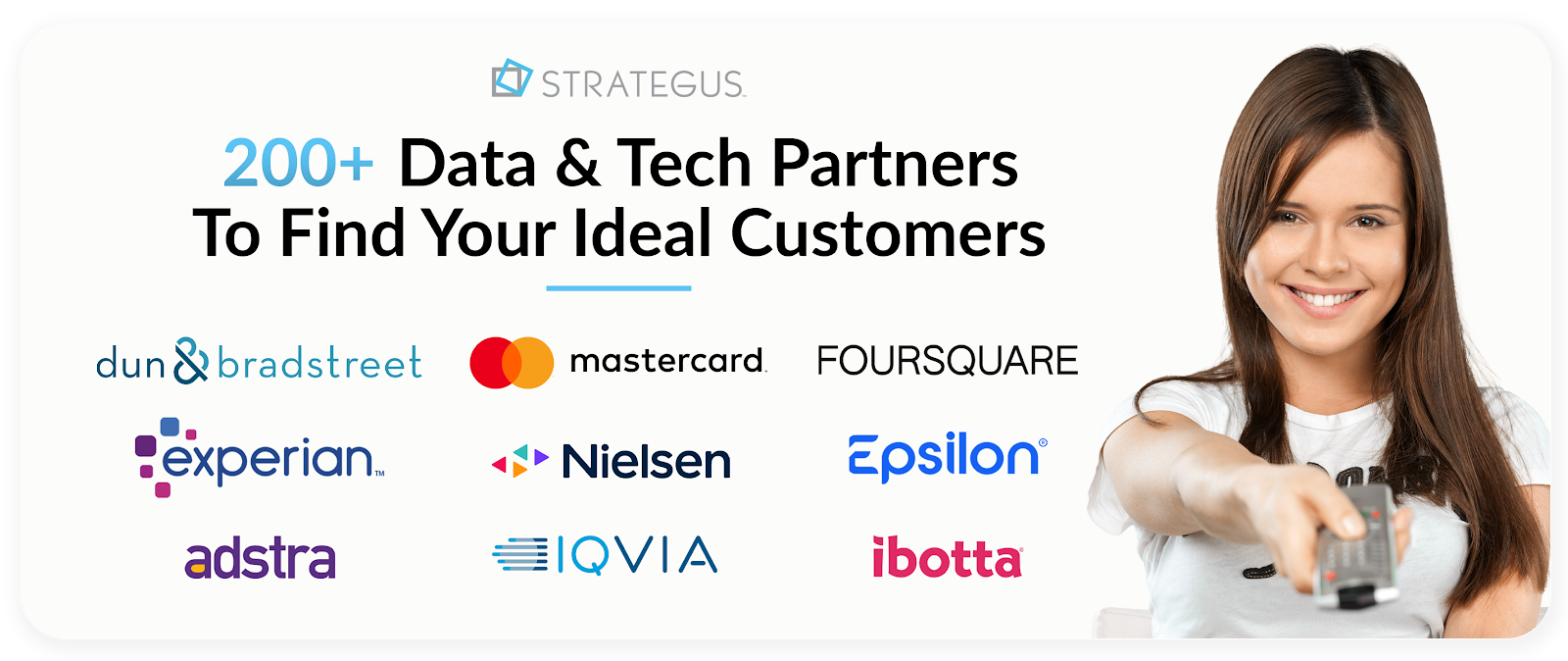
The programmatic CTV industry gives you more control over who sees your ads and when. With the right data mix, you can connect with real viewers and turn impressions into action.
At Strategus, we help brands use data the smart way. Our team combines first-party insights with third-party audience data to deliver privacy-safe, performance-driven campaigns.
Here’s what sets us apart:
- 200+ trusted data partners for unmatched reach and accuracy.
- Advanced audience modeling that finds the right viewers for every campaign.
- Custom CTV targeting strategies built around your business goals.
- Privacy-safe solutions that respect data rules while driving measurable results.
Want to reach the right audience, on the right screen, at the right time? Speak to a Strategus expert to learn more today.
Frequently Asked Questions
What Types of Audience Data Can Be Used for CTV Targeting?
CTV targeting can use several data types: demographic data (age, income, location), behavioral data (shopping or viewing habits), contextual data (content being watched), interest-based data (lifestyle or hobbies), and intent data (purchase readiness). Combining these audience layers helps advertisers reach relevant viewers with personalized and well-timed messages.
What Is Demographic Targeting in CTV Campaigns?
Demographic targeting in CTV uses details such as age, gender, income, or location to segment viewers. It helps advertisers design campaigns that reach specific groups aligned with their brand or product. For example, a financial service might target young professionals, while a luxury brand might focus on higher-income households.
Can I Geo-Target CTV Ads to Specific Regions or Markets?
Yes. CTV allows advertisers to target viewers by region, city, or even neighborhood. This geotargeting ensures ads are relevant to local markets, store locations, or service areas. For example, a local auto dealer could target nearby households, or a restaurant chain could promote limited offers in select delivery zones.
How Do Third-Party Data Providers Integrate With CTV?
Third-party data providers connect to CTV platforms through integrations with demand-side platforms (DSPs) and data management platforms (DMPs). Advertisers import third-party audience segments, such as lifestyle, shopping intent, or location data, into the DSP. The DSP then uses this data to deliver ads to matching households during programmatic buying.
How Do Advertisers Leverage CTV for Audience Targeting?
Advertisers use CTV targeting to reach specific households instead of broad demographic groups. By combining first-party and third-party data, they can identify who’s most likely to respond, control ad frequency, and track cross-device behavior. This data-driven targeting improves precision, reduces waste, and connects impressions to measurable outcomes like visits or purchases.
How Is Audience Data Used in Programmatic CTV Targeting?
Programmatic CTV uses audience data to decide which households should see a specific ad. The data signals like demographics, interests, and intent feed into automated systems that bid on available ad slots in real time. This ensures each impression reaches the right person on the right screen, improving efficiency and campaign performance.
Who Offers the Best Audience Targeting in CTV Environments?
The best targeting depends on goals and data depth. Providers like Strategus stand out by integrating 200+ data partners for precision, combining first- and third-party data for scale, and maintaining privacy-safe identity matching. The best platforms balance reach, compliance, and real performance measurement across devices and streaming services.

Traci Ruether is a content marketing consultant specializing in video tech. With over a decade of experience leading content strategy, she takes a metrics-driven approach to storytelling that drives traffic to her clients' websites. Follow her on LinkedIn at linkedin.com/in/traci-ruether or learn more at traciruether.com.
Strategus is a managed services connected TV(CTV) advertising agency with over 60,000+ campaigns delivered. Find out how our experts can extend your team and drive the result that matter most.
Talk to an Expert
Table of Contents
Seeking a Custom CTV Strategy That Delivers?
What to read next
App Event Tracking: Tie Mobile App Activity to CTV Campaigns
Let’s say you’re running a CTV campaign for a personal finance app.
5 minutes read

Stop Guessing Who Your Audience Is — Let Their Apps Tell You
Connected TV (CTV) targeting often falls in one of two camps.
8 minutes read
See Who Bought After Your Ad + How Much They Spent
You can’t improve what you can’t measure. And for years, that’s been a major problem with TV advertising.
4 minutes read
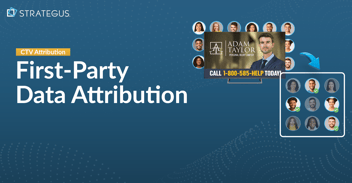
First-Party Attribution: Match Ads to Sales With CRM Data
The value of first-party data continues to grow.
7 minutes read



